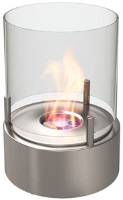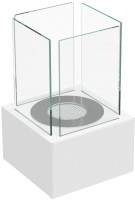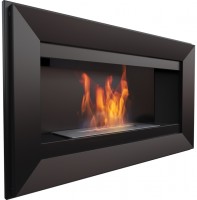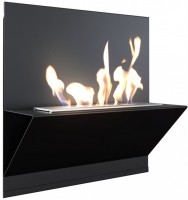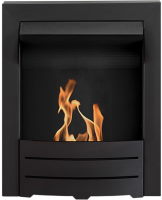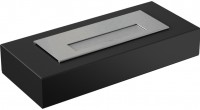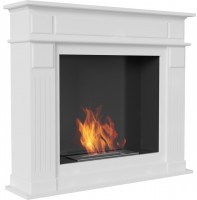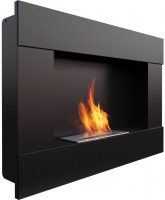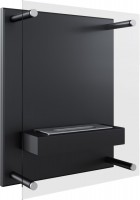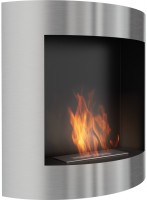Bio Fireplaces Kratki
All Bio Fireplaces Advanced filters → |
You might be interested in
Bio Fireplaces: specifications, types
Type
— Bio fireplace. It is a device that mimics traditional fireplaces. It has a complete design, with a stand and decor (and often also protective screens), and can be used without any additional equipment; in this case, bio fireplaces differ from burners (see the relevant paragraph). The resemblance to a classic wood-burning fireplace in such devices is maximized due to the presence of an open flame; for additional authenticity, decor in the form of “firewood” and “coals” made of heat-resistant materials can be added to this flame. The fuel is usually bioethanol or isopropyl alcohol with special additives. Such fuel gives a flame of a pleasant colour, without soot, unpleasant odours and dangerous combustion products; during its combustion, mainly water vapour and carbon dioxide are released. Thanks to this, bio fireplaces can be installed even in rooms, without special hoods and chimneys. At the same time, such devices not only look nice but also generate a lot of heat and can be used as additional heaters (for more details, see "Power").
— <Burner. Burners are different in that they cannot be used without additional equipment; in other words, to turn such a device into a bio fireplace, you need to add a base, and ideally, also decor and protective screens. Thus, the burners are designed primarily for those who are not satisfied with ready-made bio-fireplaces and who would like to assemble such a device on their own, according to th...eir preferences. At the same time, we note that formally all burners are built-in (see "Installation"). However, the device can be used as a floorstanding by installing it on an appropriate stand. Also, many models can be built directly into a classic wood-burning fireplace — to convert it to a safer, more efficient and environmentally friendly fuel.
— <Burner. Burners are different in that they cannot be used without additional equipment; in other words, to turn such a device into a bio fireplace, you need to add a base, and ideally, also decor and protective screens. Thus, the burners are designed primarily for those who are not satisfied with ready-made bio-fireplaces and who would like to assemble such a device on their own, according to th...eir preferences. At the same time, we note that formally all burners are built-in (see "Installation"). However, the device can be used as a floorstanding by installing it on an appropriate stand. Also, many models can be built directly into a classic wood-burning fireplace — to convert it to a safer, more efficient and environmentally friendly fuel.
Installation
The installation method determines, first of all, the appearance, and sometimes also the features of the fireplace.
— Classic floorstanding. These are devices that mimic traditional fireplaces with a frame, designed for installation close to the wall, corner models are also available. The stability of such a device is provided mainly by a massive base; for additional reliability, fastening to a wall and/or floor can be provided. Technically, you can put such a model in the middle of the room, but this does not make sense either from a practical or aesthetic point of view: the flame in such bio fireplaces is closed on three sides and is visible only from the front. Note that the design style of classic models can be different: there are richly decorated, artsy models in the retro style and strict minimalist models in the hi-tech style.
— Floor. This category includes mainly island floor bio fireplaces — devices designed for installation in the middle of the room, at a certain distance from the walls. They are somewhat more mobile than classic floorstanding fireplaces (see the relevant paragraph): the classic one is usually installed with the expectation of being permanently in one place and the floor bio fireplace can be moved around the room and even from room to room without much difficulty. Another difference is the design: this variety is most often performed in a modern minimalist style, with a combination of glass and metal. Note that an island fl...oor bio fireplace requires a fairly spacious room.
— Table. Models that do not have their stand and are mounted on a tabletop or other similar surfaces. It is one of the most compact types of bio-fireplaces, such models occupy a noticeably smaller area than floorstanding ones and weigh up to 6 kg — although their thermal power, if lower, is not much. Thanks to this, desktop models can be used as portable heaters and sources of lighting — both decorative and quite practical. For example, such a fireplace can be kept on a table in the living room and periodically taken with you for the time of evening gatherings in the gazebo.
— Wall mounted. Models suspended on the wall using self-tapping screws or other similar fasteners; such installation is easier than embedding, but more difficult than floor installation. On the other hand, wall mounted devices have a small thickness, do not take up space on the floor, and can be placed on almost any wall and at any height, which is indispensable for creating an original interior design.
— Built-in. Models designed for installation directly into the wall (however, other installation options are allowed for burners, see "Type" for details). Installation of such a fireplace is a rather complicated and time-consuming task; you need to prepare a niche, and not every wall is suitable for this. But after installation, the bio fireplace does not take up any space in the room at all — except a frame that protrudes a couple of centimetres. In addition, such a device cannot be overturned. There are also corner models that will well complement the interior in protruding walls, and columns when the fireplace must be visible not only from the front but also from the side.
— Outdoor. Bio fireplaces designed for permanent outdoor stay. Such a fireplace can be installed, for example, in a gazebo, under a canopy in the yard, on the summer terrace of a restaurant, etc. The key difference between outdoor models is increased resistance to moisture, temperature extremes, dust and other adverse factors associated with being outdoors. Some of these devices have an original design. And according to the installation method, outdoor fireplaces most often refer to either floor or tabletop fireplaces (see the relevant paragraphs).
— Classic floorstanding. These are devices that mimic traditional fireplaces with a frame, designed for installation close to the wall, corner models are also available. The stability of such a device is provided mainly by a massive base; for additional reliability, fastening to a wall and/or floor can be provided. Technically, you can put such a model in the middle of the room, but this does not make sense either from a practical or aesthetic point of view: the flame in such bio fireplaces is closed on three sides and is visible only from the front. Note that the design style of classic models can be different: there are richly decorated, artsy models in the retro style and strict minimalist models in the hi-tech style.
— Floor. This category includes mainly island floor bio fireplaces — devices designed for installation in the middle of the room, at a certain distance from the walls. They are somewhat more mobile than classic floorstanding fireplaces (see the relevant paragraph): the classic one is usually installed with the expectation of being permanently in one place and the floor bio fireplace can be moved around the room and even from room to room without much difficulty. Another difference is the design: this variety is most often performed in a modern minimalist style, with a combination of glass and metal. Note that an island fl...oor bio fireplace requires a fairly spacious room.
— Table. Models that do not have their stand and are mounted on a tabletop or other similar surfaces. It is one of the most compact types of bio-fireplaces, such models occupy a noticeably smaller area than floorstanding ones and weigh up to 6 kg — although their thermal power, if lower, is not much. Thanks to this, desktop models can be used as portable heaters and sources of lighting — both decorative and quite practical. For example, such a fireplace can be kept on a table in the living room and periodically taken with you for the time of evening gatherings in the gazebo.
— Wall mounted. Models suspended on the wall using self-tapping screws or other similar fasteners; such installation is easier than embedding, but more difficult than floor installation. On the other hand, wall mounted devices have a small thickness, do not take up space on the floor, and can be placed on almost any wall and at any height, which is indispensable for creating an original interior design.
— Built-in. Models designed for installation directly into the wall (however, other installation options are allowed for burners, see "Type" for details). Installation of such a fireplace is a rather complicated and time-consuming task; you need to prepare a niche, and not every wall is suitable for this. But after installation, the bio fireplace does not take up any space in the room at all — except a frame that protrudes a couple of centimetres. In addition, such a device cannot be overturned. There are also corner models that will well complement the interior in protruding walls, and columns when the fireplace must be visible not only from the front but also from the side.
— Outdoor. Bio fireplaces designed for permanent outdoor stay. Such a fireplace can be installed, for example, in a gazebo, under a canopy in the yard, on the summer terrace of a restaurant, etc. The key difference between outdoor models is increased resistance to moisture, temperature extremes, dust and other adverse factors associated with being outdoors. Some of these devices have an original design. And according to the installation method, outdoor fireplaces most often refer to either floor or tabletop fireplaces (see the relevant paragraphs).
Number of burners
The number of burners provided in the design of the bio fireplace.
In some fireplaces with a large width several burners installed side by side can be used. Thus, instead of being stretched across the entire width of the device, the flame is concentrated in 2 – 3 relatively small burners; due to this, the necessary "saturation" of the flame (colour and brightness) is achieved. In addition, the design may provide the possibility of igniting only a part of the burners; in this way, you can select the power and brightness of the fireplace according to the particular situation.
In some fireplaces with a large width several burners installed side by side can be used. Thus, instead of being stretched across the entire width of the device, the flame is concentrated in 2 – 3 relatively small burners; due to this, the necessary "saturation" of the flame (colour and brightness) is achieved. In addition, the design may provide the possibility of igniting only a part of the burners; in this way, you can select the power and brightness of the fireplace according to the particular situation.
Power
Thermal power is generated during the operation of the bio fireplace; for models with adjustable flame intensity, the power at maximum mode is indicated.
This parameter indicates the intensity of heating provided by the device. To evaluate this intensity, you can use the following formula: for heating 1 m2 of a room in an ordinary apartment with a ceiling height of 2.5 – 3 m, 100 W of thermal power is needed. Thus, for example, a fireplace with a power of 1.7 kW can effectively heat a room up to 17 m2. There are also more detailed, specialized formulas, including for outdoor use; they can be found in special sources. We only note that in a room a bio fireplace is usually only an additional source of heat. Therefore, the heat output data is mainly intended to know how it is worth reconfiguring the main heating system when the fireplace is turned on.
This parameter indicates the intensity of heating provided by the device. To evaluate this intensity, you can use the following formula: for heating 1 m2 of a room in an ordinary apartment with a ceiling height of 2.5 – 3 m, 100 W of thermal power is needed. Thus, for example, a fireplace with a power of 1.7 kW can effectively heat a room up to 17 m2. There are also more detailed, specialized formulas, including for outdoor use; they can be found in special sources. We only note that in a room a bio fireplace is usually only an additional source of heat. Therefore, the heat output data is mainly intended to know how it is worth reconfiguring the main heating system when the fireplace is turned on.
Fuel consumption
Consumption of fuel by a bio fireplace in normal operation, and for models with adjustable flame intensity — at maximum intensity.
Knowing the fuel consumption and tank capacity, you can calculate the burning time if it is not specified in the specs. In addition, data on consumption of the device can be useful for estimating the cost of its operation. However, the actual consumption may be less than claimed if the device is not used at full capacity; its specific meaning for such cases should be clarified already in fact.
Knowing the fuel consumption and tank capacity, you can calculate the burning time if it is not specified in the specs. In addition, data on consumption of the device can be useful for estimating the cost of its operation. However, the actual consumption may be less than claimed if the device is not used at full capacity; its specific meaning for such cases should be clarified already in fact.
Burner volume
The amount of fuel that fits into the bio fireplace burner when fully charged. For gel fuel models (see “Fuel type”) that do not have their tank and use replaceable fuel cans, this item may indicate the nominal can capacity for which the device is designed.
Knowing the volume of the burner and fuel consumption, it is possible to estimate the duration of burning, even if it is not indicated in the specs. Note that in liquid fuel models, tanks also allow incomplete refuelling. This is relevant because many bio-fireplaces are not designed for long-term storage of fuel in the tank.
Knowing the volume of the burner and fuel consumption, it is possible to estimate the duration of burning, even if it is not indicated in the specs. Note that in liquid fuel models, tanks also allow incomplete refuelling. This is relevant because many bio-fireplaces are not designed for long-term storage of fuel in the tank.
Burning time
Duration of bio fireplace burning; indicated for the maximum intensity of the flame, with a reduced intensity of combustion, the actual operating time may be longer. Thus, the duration of burning claimed in the specs is the guaranteed minimum time that the device can work on a full tank (or the shortest time required to burn a full tank of fuel — in some situations, you have to look from this side as well).
Despite the conventionality, according to this parameter, it is quite possible to compare different devices with each other.
Despite the conventionality, according to this parameter, it is quite possible to compare different devices with each other.
Fuel type
The type of fuel for which the fireplace is designed.
- Liquid. It is fuel based on bioethanol with special additives. Additives are used primarily to give the flame a pleasant, rich yellow colour; pure ethanol burns with a transparent bluish flame, so it is not recommended to pour it into the fireplace, although this is technically possible. In addition, aromatic impurities are added to some brands of fuel, so that the fireplace can also play the role of an aroma lamp. Liquid fuel is used in most modern bio fireplaces; one of its key advantages is that the fireplace can be equipped with a smooth adjustment of the intensity of the flame. In addition, the tank can be filled both completely and partially. At the same time, when using a liquid, there is a risk of spilling it, so this type of fuel requires care and accuracy in handling.
- Gel. It is fuel, usually based on isopropanol. Like liquid fuel, it can be supplemented with aromatic additives, often containing sea salt, due to which it emits a crackling sound during combustion and provides an additional resemblance to a wood-burning fireplace. Gel fuel is more practical and safer in that it is nearly impossible to spill. In addition, it is very easy to handle: just open the jar, install it in the fireplace and set it on fire. On the other hand, this method of operation does not allow you to adjust the intensity of the flame. Therefore, fireplaces for gel fuel are relatively rare.
- Liquid. It is fuel based on bioethanol with special additives. Additives are used primarily to give the flame a pleasant, rich yellow colour; pure ethanol burns with a transparent bluish flame, so it is not recommended to pour it into the fireplace, although this is technically possible. In addition, aromatic impurities are added to some brands of fuel, so that the fireplace can also play the role of an aroma lamp. Liquid fuel is used in most modern bio fireplaces; one of its key advantages is that the fireplace can be equipped with a smooth adjustment of the intensity of the flame. In addition, the tank can be filled both completely and partially. At the same time, when using a liquid, there is a risk of spilling it, so this type of fuel requires care and accuracy in handling.
- Gel. It is fuel, usually based on isopropanol. Like liquid fuel, it can be supplemented with aromatic additives, often containing sea salt, due to which it emits a crackling sound during combustion and provides an additional resemblance to a wood-burning fireplace. Gel fuel is more practical and safer in that it is nearly impossible to spill. In addition, it is very easy to handle: just open the jar, install it in the fireplace and set it on fire. On the other hand, this method of operation does not allow you to adjust the intensity of the flame. Therefore, fireplaces for gel fuel are relatively rare.
Features
— Safety glass. It is a special heat-resistant glass covering the flame of the fireplace. Such glass provides additional fire safety and protection against burns (for example, with careless hand movement near the fireplace), and also reduces the likelihood of various debris and unpleasant odours entering the flame. The design of the glass may be different, depending on the type of fireplace (see "Installation"). For example, in floor and tabletop models, two glasses are often used to enclose the burner in front and behind, or four, on all sides. But in the floor ones, this feature is extremely rare: with such a fireplace it is supposed to use a separate screen installed on the floor in front of the fire.
— Remote control. The ability to control the fireplace from a distance is extremely rare, mainly in premium models. The remote can be used to control the auto ignition (see below) and/or flame intensity.
— Auto ignition. Built-in ignition system, eliminating the need for the user to light up the fireplace manually: to light the flame, just press the button. In some models, auto ignition can even be started from the remote control. Typically, such a system uses electricity and requires batteries or plugging into an outlet. It is used mainly in expensive devices.
— Display. Usually, this is a very simple black-and-white screen capable of disp...laying a few characters, a maximum of the simplest graphics. However, even this is quite enough to display a wide variety of information related to the operation of the fireplace: power level, remaining fuel, timer settings, error messages, etc. Note that it makes sense to equip only the most advanced models with displays, so this feature is the unmistakable mark of a high-end fireplace with an abundance of additional features.
— Control via smartphone. The ability to control the bio fireplace from a smartphone or other gadget (for example, a tablet), usually through a special application. The connection, in this case, is often carried out via Wi-Fi. The convenience of this function lies not only in the remote control itself but in the fact that the application usually has quite extensive capabilities. So, the control gadget also works as an external display, it can display various data on the operation of the fireplace — the current power level, the remaining fuel, the remaining operating time, error messages and other data. In some cases, it may even provide programming for the operation of the fireplace — setting the time for automatic on and/or off, the duration of operation, etc. This feature is typical for premium models.
— Remote control. The ability to control the fireplace from a distance is extremely rare, mainly in premium models. The remote can be used to control the auto ignition (see below) and/or flame intensity.
— Auto ignition. Built-in ignition system, eliminating the need for the user to light up the fireplace manually: to light the flame, just press the button. In some models, auto ignition can even be started from the remote control. Typically, such a system uses electricity and requires batteries or plugging into an outlet. It is used mainly in expensive devices.
— Display. Usually, this is a very simple black-and-white screen capable of disp...laying a few characters, a maximum of the simplest graphics. However, even this is quite enough to display a wide variety of information related to the operation of the fireplace: power level, remaining fuel, timer settings, error messages, etc. Note that it makes sense to equip only the most advanced models with displays, so this feature is the unmistakable mark of a high-end fireplace with an abundance of additional features.
— Control via smartphone. The ability to control the bio fireplace from a smartphone or other gadget (for example, a tablet), usually through a special application. The connection, in this case, is often carried out via Wi-Fi. The convenience of this function lies not only in the remote control itself but in the fact that the application usually has quite extensive capabilities. So, the control gadget also works as an external display, it can display various data on the operation of the fireplace — the current power level, the remaining fuel, the remaining operating time, error messages and other data. In some cases, it may even provide programming for the operation of the fireplace — setting the time for automatic on and/or off, the duration of operation, etc. This feature is typical for premium models.
Body material
The main material used in the design of the body of the bio fireplace.
— Chipboard / MDF. The chipboard is cheaper, the MDF is more durable and dense. This material is popular in classic floor fireplaces (see "Installation"), which are made in an antique or similar style. To ensure fire safety, wood-based panels are treated with special compounds that give them fire resistance. However, the inserts of such fireplaces are usually finished on the inside with non-combustible materials.
— Metal. “Metal” can refer to different materials, but most often it is steel or aluminium. The differences between them in this context are insignificant: steel is somewhat cheaper, and aluminium is noticeably lighter. As for the general features, the metal cases are very durable, reliable, fireproof and have a solid appearance. They are found in all types of bio-fireplaces (see "Installation"), most often metal cases have a minimalistic, high-tech appearance.
— Glass. It is an option characteristic of high-tech/modern models. In bio fireplaces, usually, special tempered and heat-resistant glass is used. However, this material is still quite fragile; it must be protected from strong impacts. Note that the glass "body" is a rather arbitrary concept. So, in built-in models (see "Installation"), a decorative frame around the firebox can be made from this material; in table fireplaces, a glass case installed directly on the burner can simultaneously play the role o...f a protective glass; and in the wall, the burner can be fixed between two glasses, fastened with metal rods.
— Plastic. Plastic is relatively inexpensive and can be easily shaped in the most complex shapes. On the other hand, this material does not tolerate heat well; there are also heat-resistant varieties of plastic but for several reasons, this material is still not popular in bio fireplaces.
— Stone. The stone is used exclusively in classic floor fireplaces (see "Installation") as a design material that gives the device a maximum resemblance to a traditional wood-burning fireplace. The stone can be both natural and engineered, this issue should be clarified separately. Anyway, this material has a beautiful surface pattern, it is strong, reliable, durable and non-flammable. The main disadvantage of the stone is the high price. In addition, such devices are very massive, but after installation, this issue turns from a disadvantage into a virtue — it is almost impossible to tip over a stone bio fireplace.
— Concrete. Concrete is known for, on the one hand, by high strength, reliability and resistance to adverse factors; on the other hand, its high weight and poor suitability for indoor use. Therefore, such cases are extremely rare, in some models of outdoor bio fireplaces.
— Chipboard / MDF. The chipboard is cheaper, the MDF is more durable and dense. This material is popular in classic floor fireplaces (see "Installation"), which are made in an antique or similar style. To ensure fire safety, wood-based panels are treated with special compounds that give them fire resistance. However, the inserts of such fireplaces are usually finished on the inside with non-combustible materials.
— Metal. “Metal” can refer to different materials, but most often it is steel or aluminium. The differences between them in this context are insignificant: steel is somewhat cheaper, and aluminium is noticeably lighter. As for the general features, the metal cases are very durable, reliable, fireproof and have a solid appearance. They are found in all types of bio-fireplaces (see "Installation"), most often metal cases have a minimalistic, high-tech appearance.
— Glass. It is an option characteristic of high-tech/modern models. In bio fireplaces, usually, special tempered and heat-resistant glass is used. However, this material is still quite fragile; it must be protected from strong impacts. Note that the glass "body" is a rather arbitrary concept. So, in built-in models (see "Installation"), a decorative frame around the firebox can be made from this material; in table fireplaces, a glass case installed directly on the burner can simultaneously play the role o...f a protective glass; and in the wall, the burner can be fixed between two glasses, fastened with metal rods.
— Plastic. Plastic is relatively inexpensive and can be easily shaped in the most complex shapes. On the other hand, this material does not tolerate heat well; there are also heat-resistant varieties of plastic but for several reasons, this material is still not popular in bio fireplaces.
— Stone. The stone is used exclusively in classic floor fireplaces (see "Installation") as a design material that gives the device a maximum resemblance to a traditional wood-burning fireplace. The stone can be both natural and engineered, this issue should be clarified separately. Anyway, this material has a beautiful surface pattern, it is strong, reliable, durable and non-flammable. The main disadvantage of the stone is the high price. In addition, such devices are very massive, but after installation, this issue turns from a disadvantage into a virtue — it is almost impossible to tip over a stone bio fireplace.
— Concrete. Concrete is known for, on the one hand, by high strength, reliability and resistance to adverse factors; on the other hand, its high weight and poor suitability for indoor use. Therefore, such cases are extremely rare, in some models of outdoor bio fireplaces.
Burner material
The material from which the bio fireplace burner is made.
All burners are made of metal — this is the best option in terms of ease of production, reliability and fire safety. At the same time, in the vast majority of bio fireplaces, stainless steel is used as a specific material: this material is strong, resistant to corrosion and durable. There are other options — for example, aluminium — but extremely rare, mainly in those models where this is due to the design (for example, if the burner is an integral part of the aluminium body).
All burners are made of metal — this is the best option in terms of ease of production, reliability and fire safety. At the same time, in the vast majority of bio fireplaces, stainless steel is used as a specific material: this material is strong, resistant to corrosion and durable. There are other options — for example, aluminium — but extremely rare, mainly in those models where this is due to the design (for example, if the burner is an integral part of the aluminium body).



